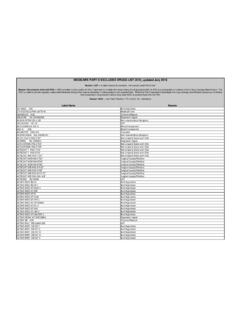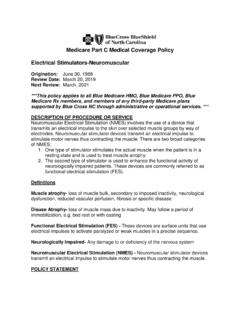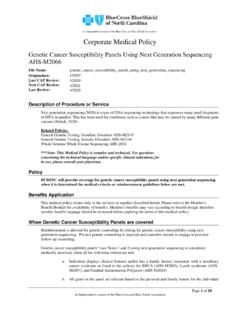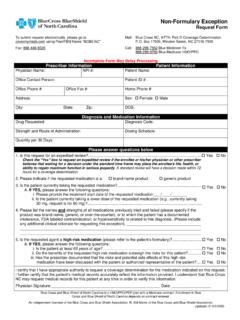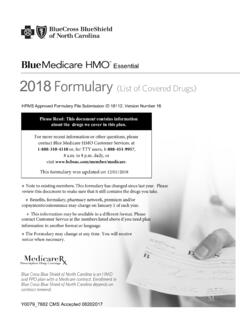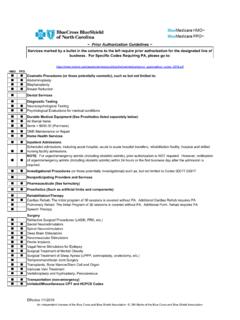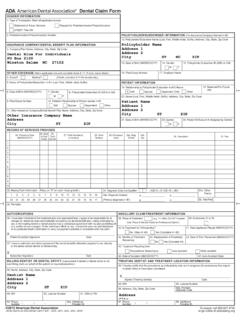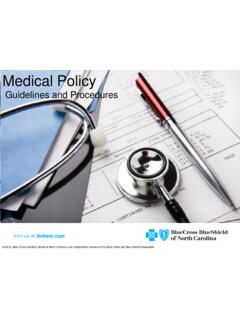Transcription of Corporate Medical Policy - Blue Cross NC
1 Corporate Medical Policy Page 1 of 16 An Independent Licensee of the Blue Cross and Blue Shield Association BRCA AHS - M2003 File Name: brca 1/2019 4/2022 Origination: Last Review: Description of Procedure or Service BRCA1 and BRCA2 are two distinct tumor suppressor genes involved in a common DNA repair process (Roy, Chun, & Powell, 2012). Germline mutations of BRCA genes are associated with an increased risk of breast and ovarian cancer, as well as other cancer types including pancreatic, and prostate cancer to a lesser extent (Paul & Paul, 2014). Related Policies: Gene Expression Testing for Breast Cancer Prognosis AHS- M2020 Genetic Cancer Susceptibility Using Next Generation Sequencing AHS-M2066 General Genetic Testing, Germline Disorders AHS-M2145 General Genetic Testing, Somatic Disorders AHS-M2146 **Note: This Medical Policy is complex and technical.
2 For questions concerning the technical language and/or specific clinical indications for its use, please consult your physician. Policy BCBSNC will provide coverage for BRCA testing when it is determined the Medical criteria or reimbursement guidelines below are met. Benefits Application This Medical Policy relates only to the services or supplies described herein. Please refer to the Member's Benefit Booklet for availability of benefits. Member's benefits may vary according to benefit design; therefore member benefit language should be reviewed before applying the terms of this Medical Policy . When BRCA is covered Application of coverage criteria is dependent upon an individual s benefit coverage at the time of the request. Consideration of both maternal and paternal family histories is necessary in the evaluation of individuals for risk of carrying a mutation in the BRCA1 or BRCA 2 gene; each lineage must be considered separately.
3 1. With a known familial mutation, testing for a BRCA1 or 2 gene mutation is considered medically necessary in an individual who has received genetic counseling and is at least 18 years of age, with the following conditions: a) Testing is limited to known familial mutation b) If the specific familial mutation is known, BRCA panel testing is covered in accordance with AHS-Page 2 of 16 An Independent Licensee of the Blue Cross and Blue Shield Association BRCA AHS - M2003 M2066 Genetic Cancer Susceptibility Using Next Generation Sequencing. 2. With a diagnosis of breast cancer, testing for BRCA1 and BRCA2 gene mutations, is considered medically necessary in an individual who has received genetic counseling and who meets any of the following criteria: a) Diagnosed with breast cancer and at least one of the following: i.
4 Diagnosed at age < 45 years of age; or ii. Diagnosed between ages 46 and 50 years and one of the following: (a) An additional breast cancer diagnosed at any age: or (b) At least one close blood relative (See Note 1) with breast, ovarian, pancreatic, or prostate cancer at any age; or (c) An unknown or limited family history ( , adopted or fewer than 2 first-or second-degree female relatives surviving beyond age 45 years in either lineage) iii. Diagnosed with breast cancer at 51 years with AND (a) At least one close blood relative (See Note 1) with ANY of the following: (i) Breast cancer at age 50 year or male breast cancer at any age (ii) Ovarian cancer at any age (iii) Pancreatic cancer at any age (iv) Metastatic, intraductal/cribriform histology, or high-over very-high risk group prostate cancer at any age (defined as Gleason score 8 or higher, PSA 20 or higher, intraductal/cribriform histology, or stage III or higher- , extends through prostate capsule) Or (b) A combined total of at least three diagnoses of breast cancer in patient and/or close blood relatives (See Note 1); or (c) At least two close blood relatives (See Note 1) with either breast or prostate cancer (any grade) at any age iv.
5 Diagnosed at any age: (a) Of Ashkenazi Jewish ancestry; or (b) Lobular breast cancer with personal or family history of diffuse gastric cancer; or (c) Diagnosed with triple negative breast cancer; or (d) Diagnosed with male breast cancer; or (e) Diagnosed with at least one close blood relative with male breast cancer b) Has a history of ovarian cancer (including fallopian tube cancer or peritoneal cancer) at any age (excluding germ cell cancers) c) Has a history of pancreatic cancer at any age (excluding neuroendocrine pancreatic cancer) d) Has a history of prostate cancer at any age with one of the following: i. Has a history of high- or very-high-risk group (See Note 2) prostate cancer at any age (defined as Gleason score 8 or higher, PSA 20 or higher, intraductal/cribriform histology, or stage III or higher , extends through prostate capsule) ii.
6 Any personal history of prostate cancer (See Note 2) with the following family history: (a) Is of Ashkenazi Jewish ancestry; or (b) >1 close blood relative (See Note 1) with breast cancer at age 50 years or ovarian, pancreatic, metastatic, or intraductal/cribriform prostate cancer at any age; or (c) Two or more close blood relatives (See Note 1) with either breast or prostate cancer of any grade at any age Page 3 of 16 An Independent Licensee of the Blue Cross and Blue Shield Association BRCA AHS - M2003 e) Has a BRCA 1 or 2 mutation detected by tumor genomic profiling in the absence of germline mutation testing f) Patient is being considered for treatment with a PARP (PolyADP-ribose polymerase) inhibitor or for platinum therapy g) Patient is being considered for adjuvant treatment with Olaparib for high-risk, HER2 negative breast cancer h) Patient meets Li-Fraumeni syndrome (LFS) or Lynch syndrome testing criteria.
7 For multi-gene next generation sequencing panel testing, please refer to AHS-M2066-Genetic Cancer Susceptibility Using Next Generation Sequencing i) Patient meets testing criteria for Cowden syndrome/PTEN hamartoma tumor syndrome 3. With a known family history of BRCA related cancers, testing for BRCA 1 or 2 gene mutation is considered medically necessary in an individual who has received genetic counseling and is at least 18 years of age ONLY if the family members affected by breast, ovarian, pancreatic, metastatic or intraductal prostate cancer, fallopian tube, or primary peritoneal cancers are not available for testing AND: a) Individual has a first or second degree blood relative meeting any of the above criteria for individual with cancer (if the affected relative has pancreatic or high-risk or very high-risk prostate cancer only first-degree relatives should be offered testing unless indicated for other relatives based on additional family history), or b) Individuals who have family members with breast, ovarian, tubal, or peritoneal cancer with positive screening results (probability of 5% or greater) from a tool (See Note 3) designed to identify a family history that may be associated with an increased risk for potentially harmful mutations in breast cancer susceptibility genes (BRCA1 or BRCA2).
8 C) An Ashkenazi Jewish individual (See Note 4) When BRCA is not covered for BRCA 1 and BRCA 2 is considered not medically necessary for the following: a) Genetic testing in minors < 18 years of age b) General population screening c) Women diagnosed with breast cancer at age > 65 years, with no close relative (See Note 1) with breast, ovarian, pancreatic, or prostate cancer as there is a low probability that testing will have findings of documented clinical utility d) Men diagnosed with localized prostate cancer with Gleason Score <7 and no close blood relative (See Note 1) with breast, ovarian, pancreatic, or prostate cancer as there is a low probability that testing will have findings of documented clinical utility e) In all other situations not specified above 2.
9 Testing family members for a variant of unknown significance is considered investigational. *Note 1: Close blood relatives include 1st-degree relatives ( , parents, siblings, and children), 2nd-degree relatives ( , grandparents, aunts, uncles, nieces, nephews, grandchildren, and half-siblings), and 3rd-degree relatives (great-grandparents, great-aunts, great-uncles, great-grandchildren, and first cousins), all of whom are on the same side of the family. Page 4 of 16 An Independent Licensee of the Blue Cross and Blue Shield Association BRCA AHS - M2003 *Note 2: Risk groups are defined in NCCN Guidelines for Prostate Cancer http:// *Note 3: According to the USPSTF recommendation in 2019, the risk tools evaluated by the USPSTF include the Ontario Family History Assessment Tool, Manchester Scoring System, Referral Screening Tool, Pedigree Assessment Tool, 7-Question Family History Screening Tool, International Breast Cancer Intervention Study instrument (Tyrer-Cuzick), and brief versions of BRCAPRO.
10 They do not specifically state the preference of one tool over any of the others listed. According to the USPSTF, these tools should be used to guide referrals to genetic counseling. (USPSTF, 2019). *Note 4: Testing of Ashkenazi Jewish individuals without a known familial mutation should be initially limited to the three known founder mutations (185delAG and 518insC in BRCA1; 617delT in BRCA2) if the patient being tested has no personal or family history of BRCA-related cancers. (This would allow for members with cancer and strong family history to start with comprehensive testing over founder mutations). Policy Guidelines BRCA1 and BRCA2 are critical genes in the process of homologous recombination repair of double-strand DNA breaks (Walsh, 2015) Both genes are very large (occupying about 70 kb) and encode a combined total of 49 exons.
![PRESCRIBER NAME PRESCRIBER NPI [REQUIRED] …](/cache/preview/a/b/7/0/1/8/c/4/thumb-ab7018c4458f456b9838d088cff776b6.jpg)
